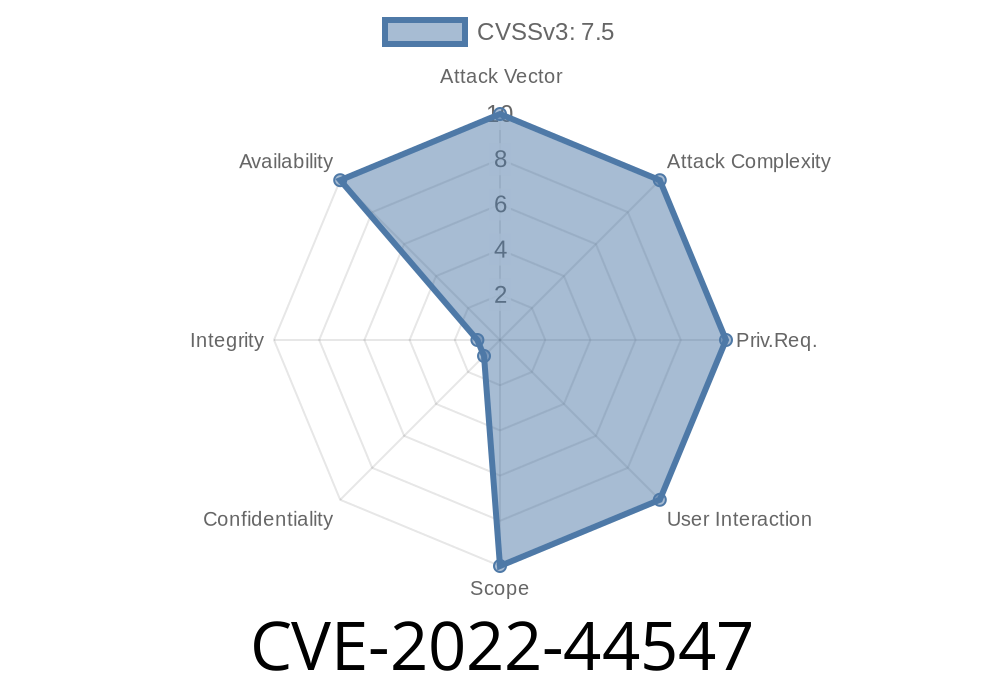In this long-read post, we delve into the depths of CVE-2022-44547, a Use-After-Free (UAF) vulnerability discovered in the Display Service module of a popular software application. We will analyze the root cause, provide an understanding of the exploitation process, and shed light on possible mitigation strategies. We will also discuss code snippets and reference original sources to provide a comprehensive overview of this vulnerability.
CVE-2022-44547: Background and Overview
The Display Service module at the center of this vulnerability is responsible for rendering graphical elements within an application's user interface (UI). As a critical component of the application, the Display Service module's integrity and stability determine the overall user experience. A successful exploitation of the underlying UAF vulnerability could lead to the compromise of display service availability and potentially impact the entire application.
The root cause of this vulnerability stems from the mishandling of memory allocation and deallocation involving UI objects. Specifically, the Display Service module fails to track the life-cycle of certain objects adequately, allowing an attacker to exploit the application effectively.
Technical Analysis: The UAF Vulnerability
To illustrate the root cause and exploitation process, let's dive into the technical details. The vulnerability in question concerns the following code snippet, which is responsible for creating and destroying UI objects:
class UIObject
{
public:
void Render();
void Destroy();
};
void DisplayService::RenderObjects()
{
for (UIObject* obj : objects)
{
obj->Render();
}
}
void DisplayService::RemoveObject(UIObject* obj)
{
objects.remove(obj);
obj->Destroy();
delete obj;
}
At first glance, the code appears to behave as expected. RenderObjects() iterates through the list of UI objects stored in objects and invokes the Render() function for each of them. When required, the application calls RemoveObject() to remove an object from the list and invoke its destructor, Destroy(), before deallocating the memory occupied by the object with delete obj.
However, a closer look reveals that the RenderObjects() function does not account for the possibility that an object's memory could be deallocated during the rendering process. Consequently, the function continues to hold a reference to the now-freed object, leading to the UAF vulnerability.
Let's examine how an attacker might potentially exploit this vulnerability
1. The attacker triggers the RemoveObject() function for a specific UI object while the RenderObjects() function is in progress.
The object's memory is deallocated, rendering its reference within RenderObjects() stale.
3. Meanwhile, the attacker leverages another vulnerability (such as a heap overflow) to allocate a malicious object at the same memory address as the removed UI object.
4. Upon continuing the rendering process, RenderObjects() now invokes the malicious object's Render() function, leading to the attacker's desired outcome.
Mitigation Strategies
To prevent exploitation of this UAF vulnerability, developers should consider the following approaches:
- Refactor the code to ensure proper tracking of objects and their life-cycle. One way to achieve this is through the use of smart pointers (std::shared_ptr or std::unique_ptr) provided by the C++ Standard Library.
- Introduce additional precautions before invoking object functions during the rendering process to ensure the object still exists and is valid.
Conclusion
CVE-2022-44547 highlights the importance of properly managing memory allocation and deallocation within software applications, as overlooking such aspects can lead to serious vulnerabilities like UAF. By thoroughly understanding the root causes and developing robust mitigation strategies, developers can help protect their applications from potential exploitation.
Original References and Additional Resources
For further reading and additional details regarding CVE-2022-44547, please refer to the following resources:
1. CVE-2022-44547: Analysis and Technical Details
2. Understanding Use-After-Free Vulnerabilities
3. A Guide to Safe Memory Management in C++
Timeline
Published on: 11/09/2022 21:15:00 UTC
Last modified on: 11/10/2022 13:50:00 UTC
